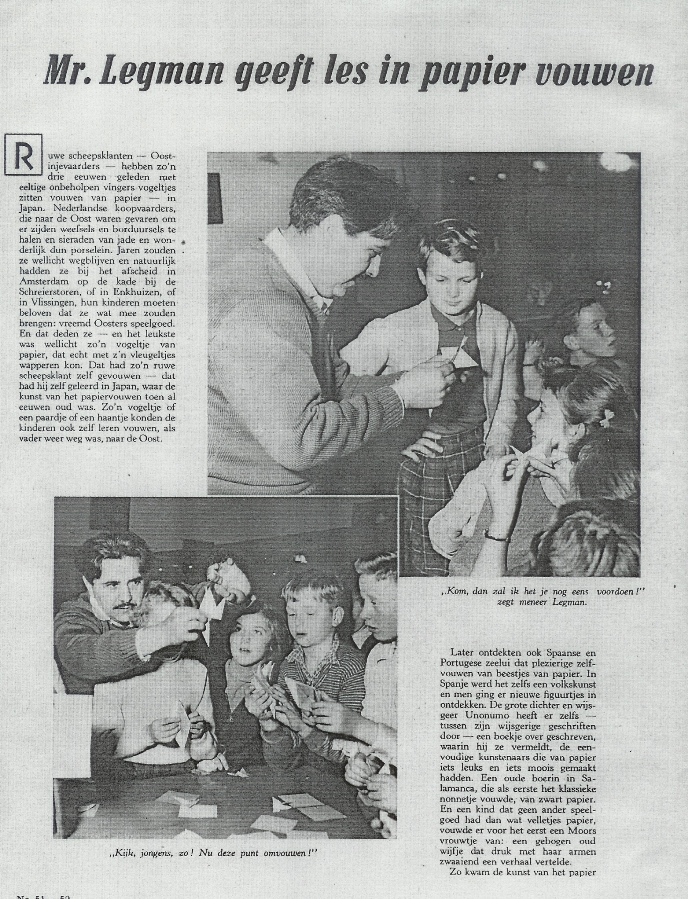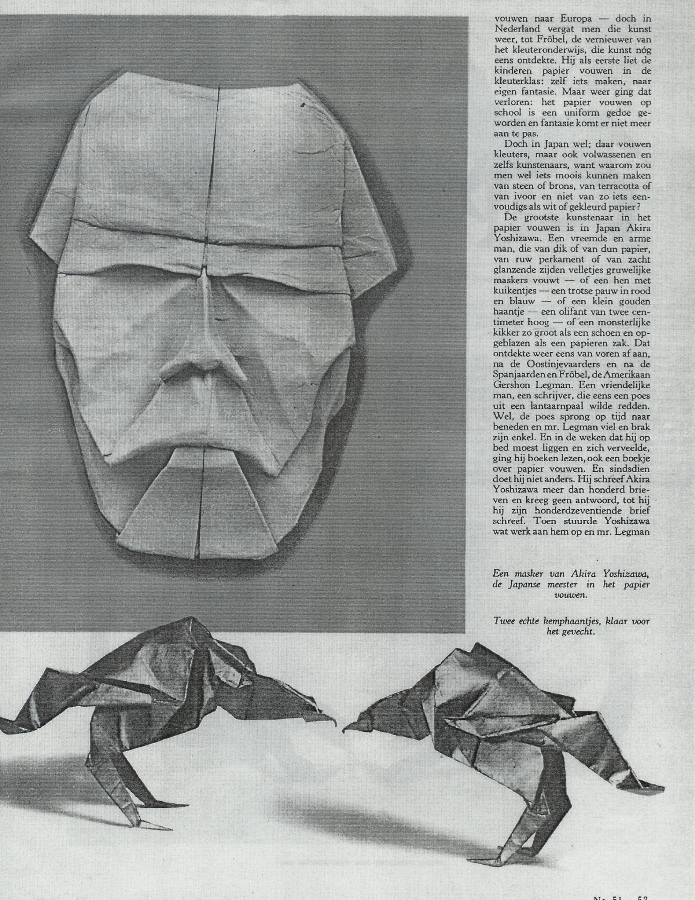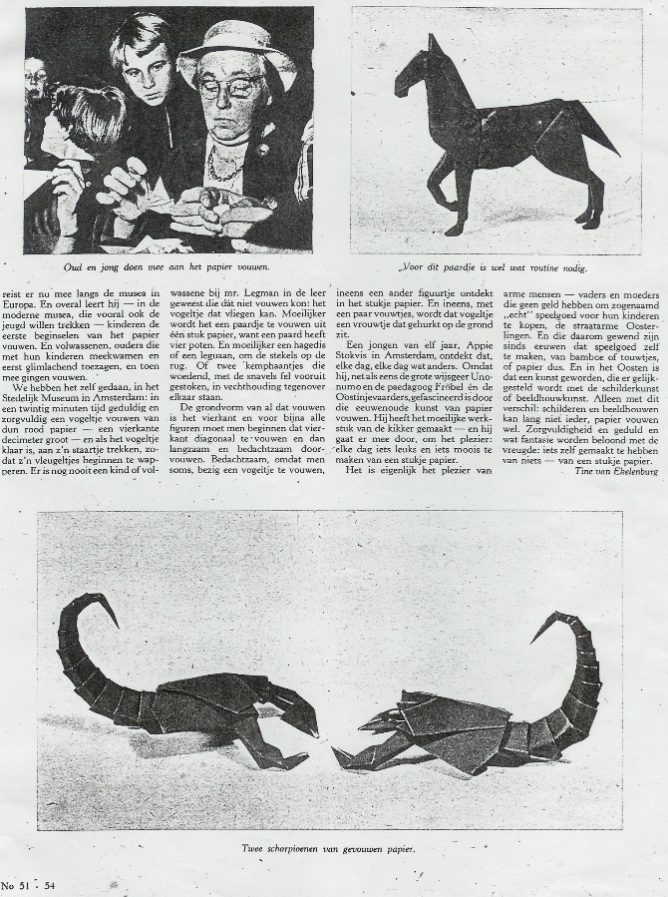| The Public Paperfolding History Project
Last updated 27/3/2024 x |
|||||||
| Article in Goed Nieuws dated 17th December, 1955 | |||||||
| The
copy of this article about the exhibition of Akira
Yoshizawa's work in Amsterdam in 1955 shown below is
undated and does not identify the publication. However,
it can be identified from quotations from the article
found in David Lister's article 'The 1955 Exhibition By Akira
Yoshizawa',
published on the BOS website and dated 5th and 8th March,
2005. Gershon Legman was presumably the source for (most
of, if not all) the information in this article. The historical information given in this article should not be relied on without supporting evidence. In particular note that: 1, The theory that first Dutch and then Spanish and Portuguese sailors brought paperfolding back to Europe lacks evidence to support it. 2, There is no evidence from Japan to suggest that the Flapping Bird is Japanese in origin. 3, The statement that Legman 'wrote over a hundred letters to Yoshizawa but got no reply until he wrote his one hundred and seventeenth letter' is untrue. 4, As is the statement that 'Mr Legman now travels with it around the museums of Europe.' 5, 'An old peasant woman in Salamanca was the first to fold the classic black paper nun. And a child who had no other toy than a few sheets of paper, for the first time folded a Moorish woman out of it, a stooped old woman who, frantically waving her arms, told a story.' I have not been able to identify which designs are being referred to here.. **********
********** Roughly paraphrased to English the article reads: 'Mr Legman teaches paper folding' 'Three centuries ago in Japan, Dutch seamen, who had sailed to the East to fetch silks, fabrics and embroidery, and jewellery made of jade, and wonderfully thin porcelain, sat around folding birds out of paper with clumsy fingers. They would probably stay away for years and, of course, when they said goodbye in Amsterdam, on the quay at Schreierstoren or Enkhuizen or Vlissingen, they would have promised their children that they would bring back strange Eastern gifts. And they did, and the best of these was probably one of those little paper birds that could really flap its wings. The seamen would have learned to fold this themselves in Japan, where the art of paperfolding was already centuries old. The children could also learn such a bird or a horse or a rooster themselves, to fold when father was away again in the East.' 'Later on Spanish and Portuguese sailors also discovered the joy of folding paper creatures. In Spain it even became a folk art and new figures were discovered. The great poet and sage Unamuno has even written a little book about them, in between his philosophical writings, in which he mentions the simple artists who had made something fun and beautiful out of paper. An old peasant woman in Salamanca was the first to fold the classic black paper nun. And a child who had no other toy than a few sheets of paper, for the first time folded a Moorish woman out of it, a stooped old woman who, frantically waving her arms, told a story.' 'That's how the art of paper folding reached Europe, but in the Netherlands they forgot the art again, until Frobel, the inventor of kindergarten education, discovered the art once more. He was the first to have the children fold paper in kindergarten and to make something themselves according to their own imagination. But that was lost again: folding paper at school has become a uniform task and imagination is no longer involved. But in Japan toddlers fold, but also adults and even artists, because why should one make something beautiful from stone or bronze or terracotta or ivory but not from something as simple as white or coloured paper?' 'The greatest paper artist in Japan is Akira Yoshizawa, a strange and poor man, who folds gruesome masks of thick or thin paper, of rough parchment or of softly shiny silk sheets, or a hen with chicks, a proud peacock in red and blue, a little golden rooster, an elephant two inches high, or a monstrous frog the size of a shoe and blown up like a paper bag. After the seamen, the Spaniards, and Frobel, paperfolding was discovered again by the American, Gershon Legman, a friendly man, a writer, who once wanted to rescue a cat from a lampost. The cat jumped down but Mr Legman fell and broke his ankle. In the weeks when he had to lie in bed and was bored he started reading and folding paper, and he has been at it ever since. He wrote over a hundred letters to Yoshizawa but got no reply until he wrote his one hundred and seventeenth letter. Then Yoshizawa sent him some work and Mr Legman now travels with it around the museums of Europe. And in all the modern museums, who want to attract young people, he teaches the rudiments of paper folding. And adults, parents who come with their children, first look on with a smile and then start folding themselves.' 'We did this ourselves. In the Stedelijk Museum in Amsterdam. In twenty minutes, we folded a bird from thin red paper 10 centimetres square. When the bird is ready, pull its tail so that its wings begin to flap.' 'There has never been a child taught by Mr Legman who could not fold the bird that can fly. It is more difficult to fold a horse from one piece of paper because a horse has four legs, and more difficult still to fold a lizard or an iguana, because of the spines on the back, or two cocks that are enraged with their beaks stabbed fiercely in front in a fighting position, standing together.' 'The basic shape of all these is the square, and for almost all figures you start by folding it diagonally and then continue slowly and thoughtfully. Thoughtfully, because sometimes, busy folding a bird, you suddenly discover another figure in the piece of paper. Suddenly, with a few folds, that bird turns into a female squatting on the floor. In Amsterdam, an eleven-year-old boy, Appie Stokvis, discovered something different every day, because, just like the seamen and the great sage Unamuno and the pedagogue Frobel, he is fascinated by the art of folding paper. He found the frog difficult, but continued with it. Folding paper is something fun, and something beautiful to do each day.' 'It's actually an amusement for poor people - fathers and mothers who have no money to buy real toys for their children, and the poverty stricken Orientals, who for this reason used to make, for centuries, toys for themselves from bamboo or string or paper. In the East (paper folding) has become an art equal to painting or sculpture, only with this difference: not everyone can paint or sculpt, but everyone can fold paper. Care and patience and imagination are rewarded with the joy of having made something from nothing - from just a piece of paper.' TIne van Ekelenburg. I am grateful to Edwin Corrie for providing the translation of the last paragraph which was otherwise impenetrable to me. ********** |
|||||||


